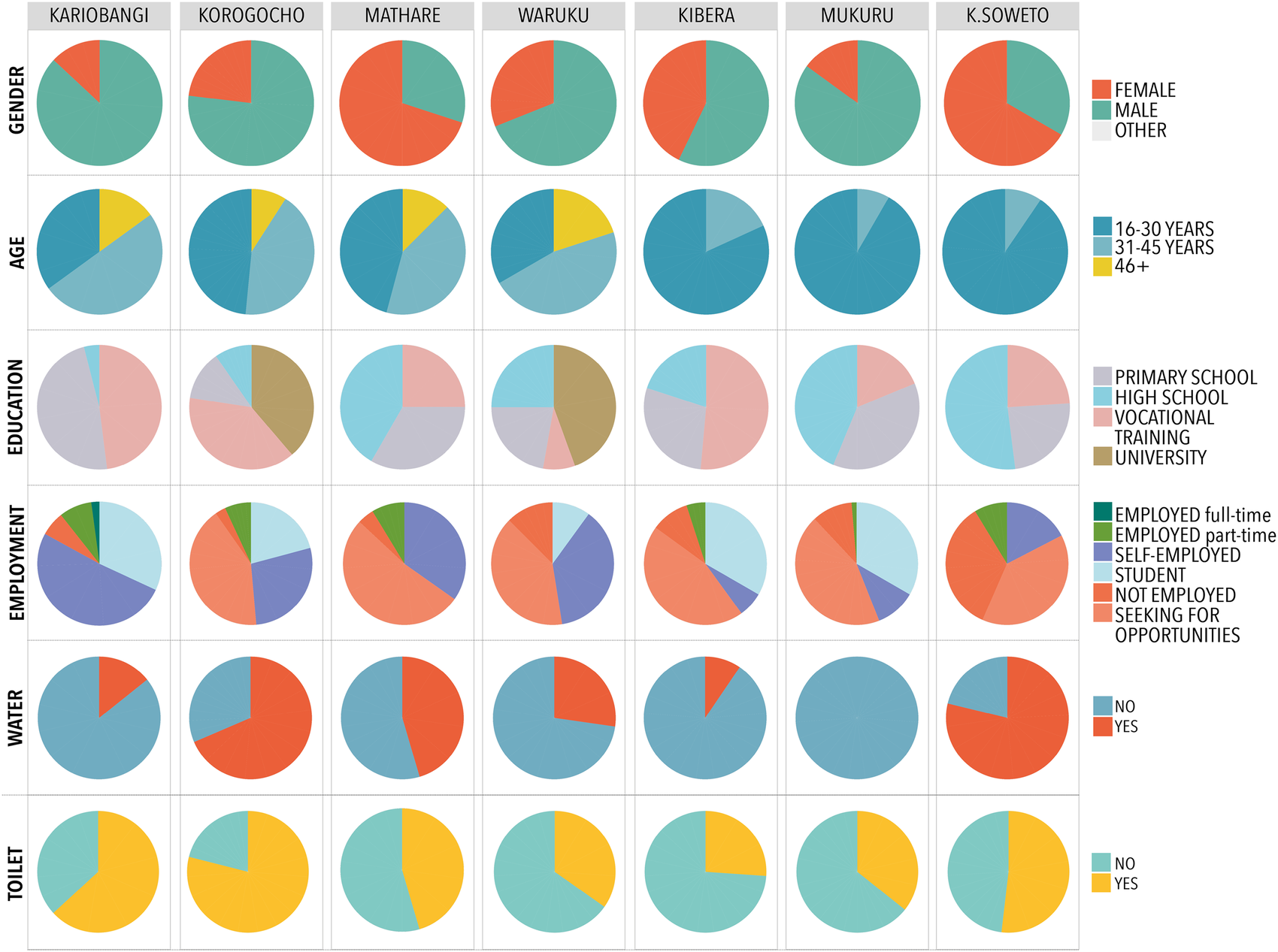In a paper published in the journal Npj Urban Sustainability, researchers explored using artificial intelligence (AI) and earth observation (EO) techniques to predict citizen perceptions of deprivation in urban slums. They developed a methodology combining satellite imagery, citizen science, and AI to compute a deprivation perception score from resident votes.
 The pie charts illustrate key socio-economic indicators that define the participants’ profiles, namely their gender, age, education level, employment, access to tap water, and access to toilets. Each slum is represented in a separate column. Image Credit: https://www.nature.com/articles/s42949-024-00156-x
The pie charts illustrate key socio-economic indicators that define the participants’ profiles, namely their gender, age, education level, employment, access to tap water, and access to toilets. Each slum is represented in a separate column. Image Credit: https://www.nature.com/articles/s42949-024-00156-x
The results demonstrated the effectiveness of AI, particularly deep learning (DL), in accurately forecasting citizen perception, offering valuable insights for policymakers aiming to address urban development challenges. This predictive tool has the potential to inform evidence-based interventions aligned with Sustainable Development Goal 11 (SDG-11), benefiting a significant portion of the global urban population residing in slum areas.
Related Work
Past work has highlighted the intricate challenges of urban inequality, particularly in deprived areas known as 'slums,' stemming from rapid urbanization in low- and medium-income countries (LMICs). These areas exhibit physical deprivation and intertwine with other forms of deprivation, such as energy poverty and environmental risks, exacerbating sustainable urban living issues.
EO methods, bolstered by AI, have made strides in capturing urban features, yet reliable data on slum deprivation remains scarce due to limited in situ data. Efforts to bridge this gap have explored integrating EO data, citizen science, and AI, aiming for more comprehensive assessments of urban areas. However, challenges persist, particularly in LMICs, where street-level coverage for citizen science assessments is limited, highlighting the ongoing global issue of unequal data access.
Nairobi Slum Methodology
The methods focus on Nairobi's slum areas, totaling approximately 20 square kilometers, employing a grid-based approach with 1998 square grids of one hectare each. Researchers utilized five geospatial datasets, including a very-high-resolution WorldView-3 (WV3) image, land-cover classification derived from WV3, OpenStreetMap (OSM) roads and rivers, and Google Open Buildings.
The conventional ML models utilized features derived from all datasets, while DL models solely employed WV3 image bands. The workflow involved citizen science, EO-based DL, and EO-based machine learning (ML).
During the citizen science phase, slum residents actively generated a deprivation-score database by conducting pairwise comparisons of satellite images. This citizen engagement necessitated proactive measures in experimental design to address challenges such as accessibility, urban morphology complexities, and community engagement concerns. Over three months, 186 participants with diverse socio-economic profiles actively contributed to the project, ensuring comprehensive representation across the studied slum areas.
Researchers employed two convolutional neural network (CNN) architectures for the DL approach: visual geometry group (and DenseNet-121. The VGG model was trained from scratch on WV3 images, while the DenseNet-121 architecture utilized transfer learning from a pre-trained ImageNet model fine-tuned on the dataset. Researchers also implemented data augmentation to mitigate overfitting.
Meanwhile, nine ML models were designed in the ML experiments, incorporating various combinations of features extracted from geospatial datasets. Researchers applied feature selection techniques to prevent overfitting, and they evaluated ML regressors, including support vector machines (SVM), random forest (RF), and eXtreme gradient boosting.
The ML experiment that provided the best accuracy was further analyzed to determine the significance of urban characteristics defining deprivation, employing the RF algorithm's feature importance assessment. This comprehensive methodological approach allowed for a nuanced understanding of urban deprivation patterns in Nairobi's slum areas, integrating citizen science, EO data, and advanced AI techniques.
Research Methodology Overview
The study utilized satellite imagery and citizen science to assess urban deprivation in Nairobi's slum areas. Researchers facilitated a pairwise comparison method using a mobile website, resulting in over one million recorded votes and contributing to the creation of a deprivation-score database. The TrueSkill rating system was employed to assign deprivation scores to image subsets, resulting in a detailed map illustrating perceived deprivation patterns.
AI models, including deep learning (DL) and conventional machine learning (ML) approaches, were developed to predict deprivation scores from satellite imagery. DL models, particularly when utilizing pre-trained architectures, accurately predicted deprivation scores. Conventional ML models, such as random forest and support vector machine, also performed well and offered advantages in interpretability.
DL models effectively captured geographic patterns of deprivation scores, with residual analysis indicating consistency between predicted and citizen-based scores. While some discrepancies were observed, such as over-predictions associated with adverse environmental elements, overall, DL models accurately represented deprivation patterns in Nairobi's slum areas.
Feature importance analysis conducted with conventional ML models identified critical predictors of deprivation scores, including factors such as road density, building proportion, and roof color. These findings align with community perceptions of deprivation indicators and provide valuable insights for targeted interventions and resource allocation to improve the well-being of affected communities.
Conclusion
To summarize, the study employed satellite imagery and citizen science to assess urban deprivation in Nairobi's slum areas. A deprivation-score database was created through pairwise comparisons facilitated by a mobile website, contributing to a detailed map illustrating perceived deprivation patterns.
AI models, including deep learning and conventional machine learning approaches, accurately predicted deprivation scores, with DL models effectively capturing geographic patterns. Feature importance analysis identified critical predictors of deprivation scores, providing valuable insights for targeted interventions and resource allocation to improve community well-being in Nairobi's slum areas.